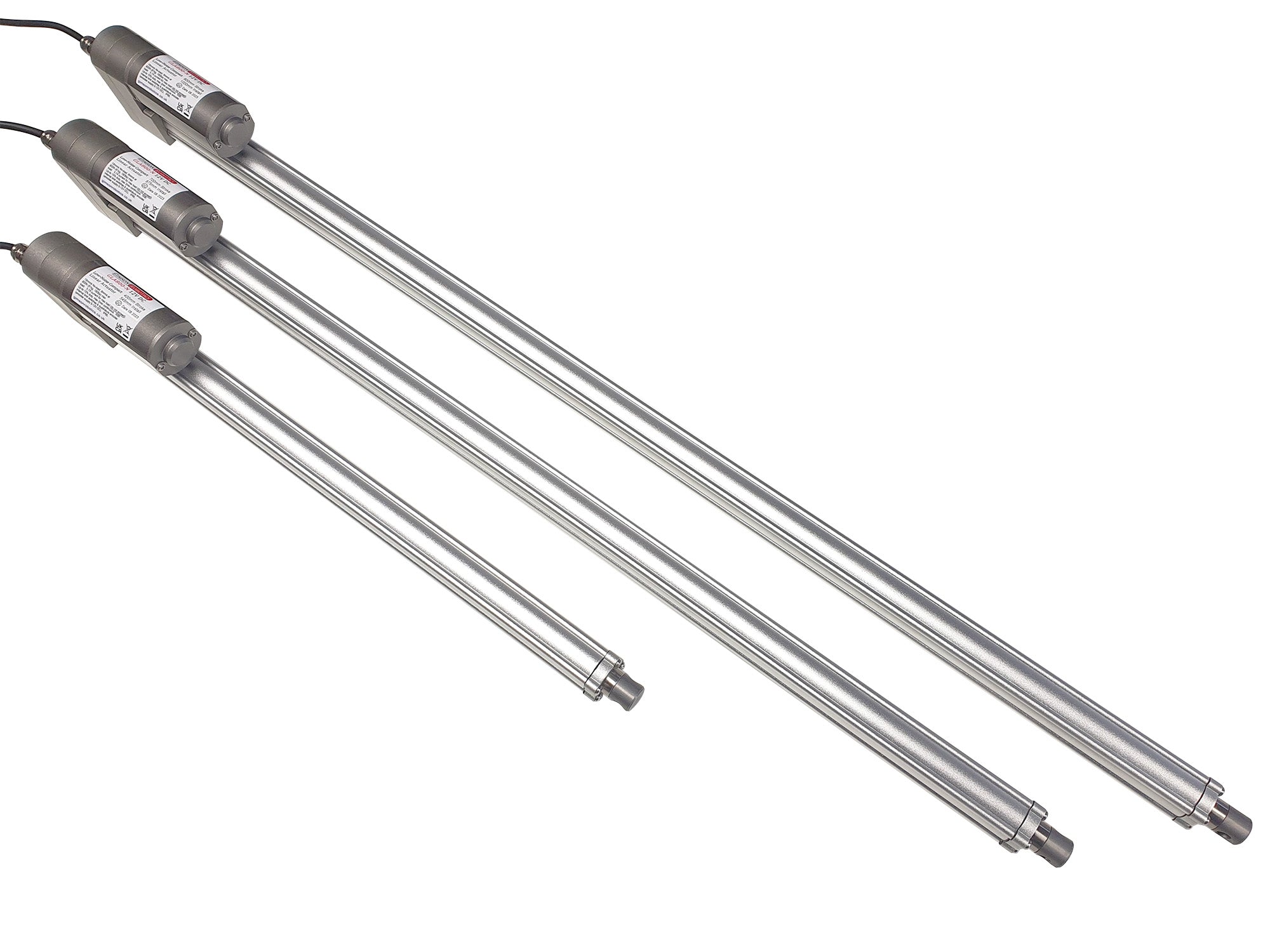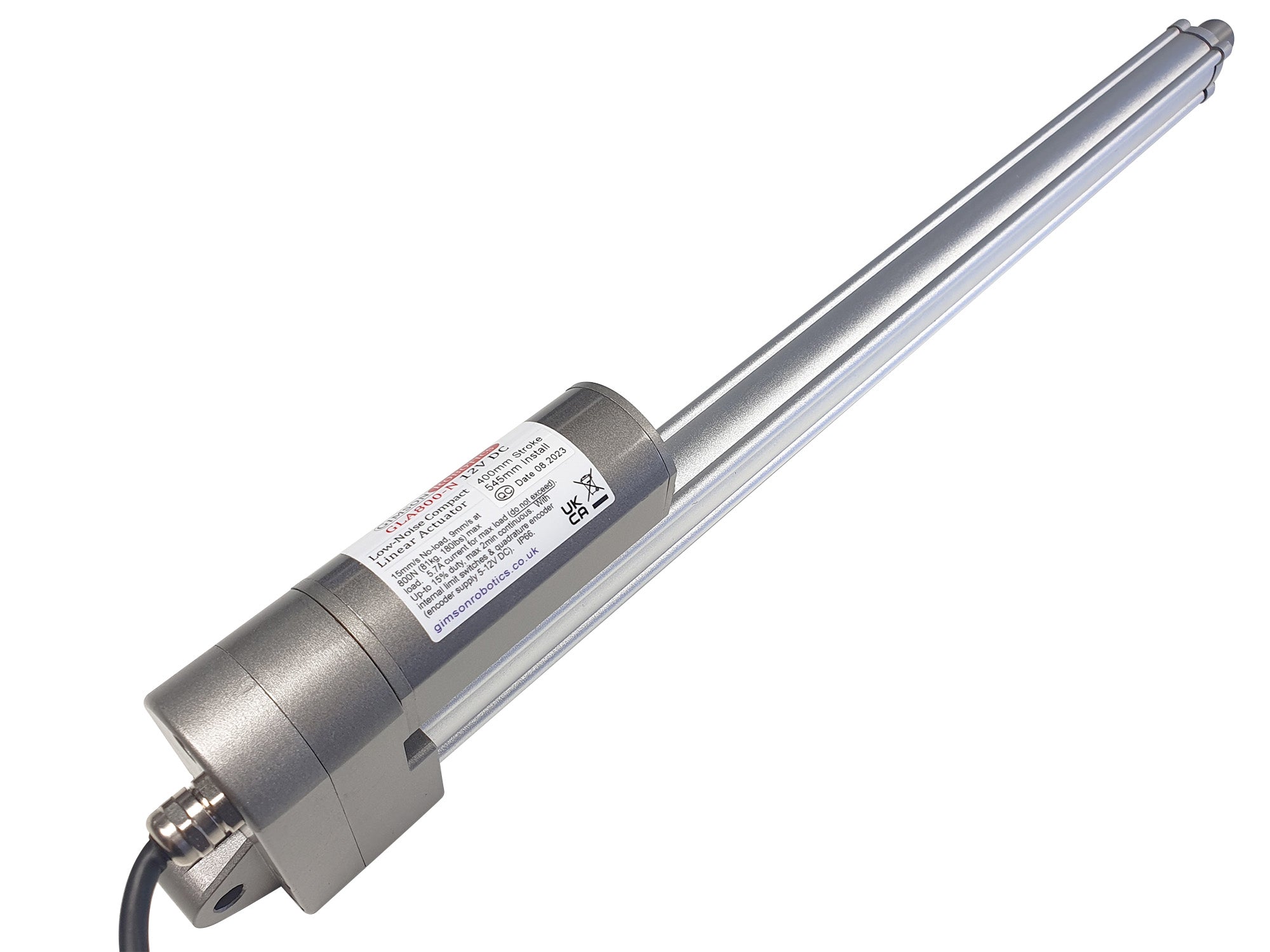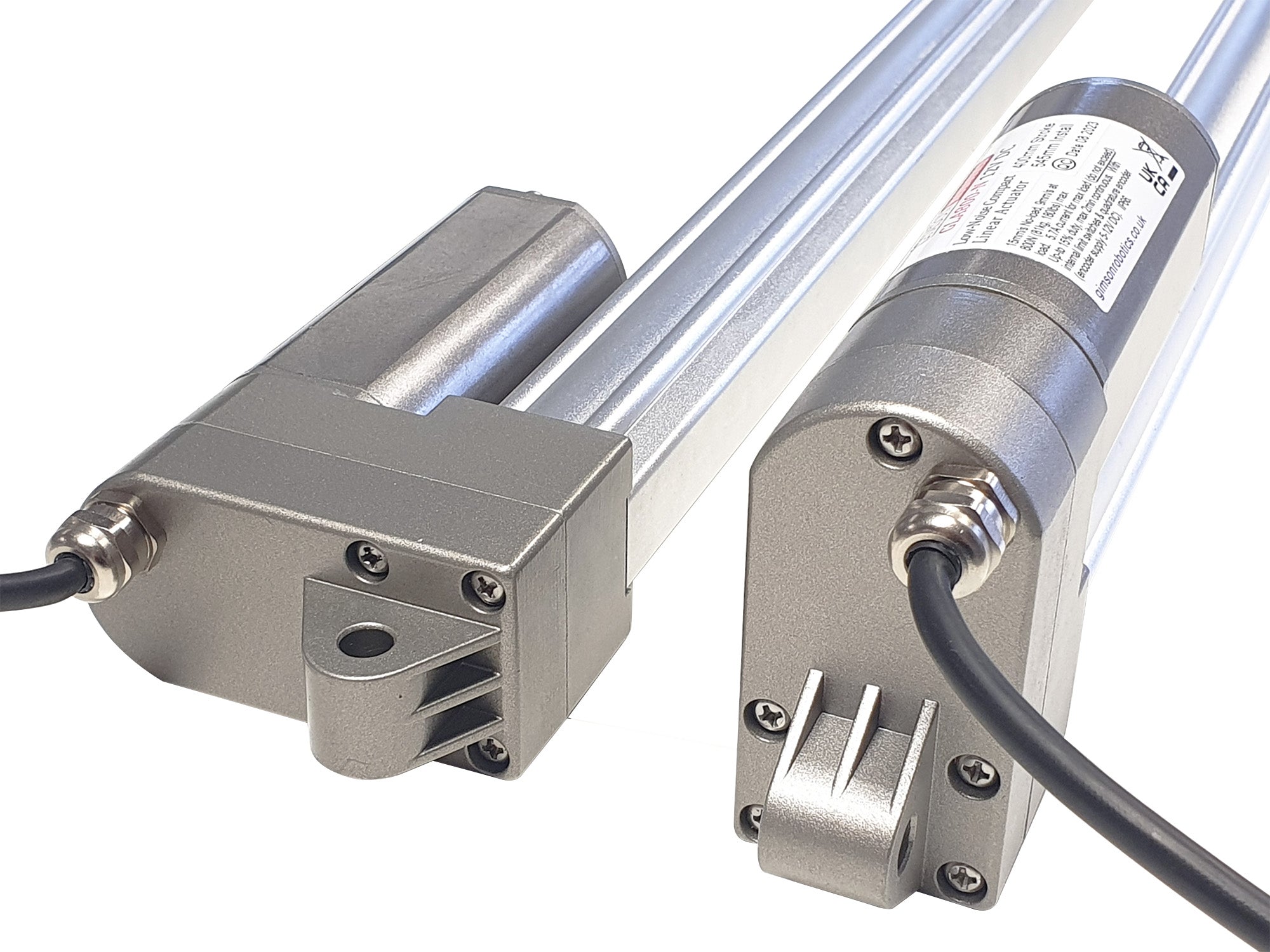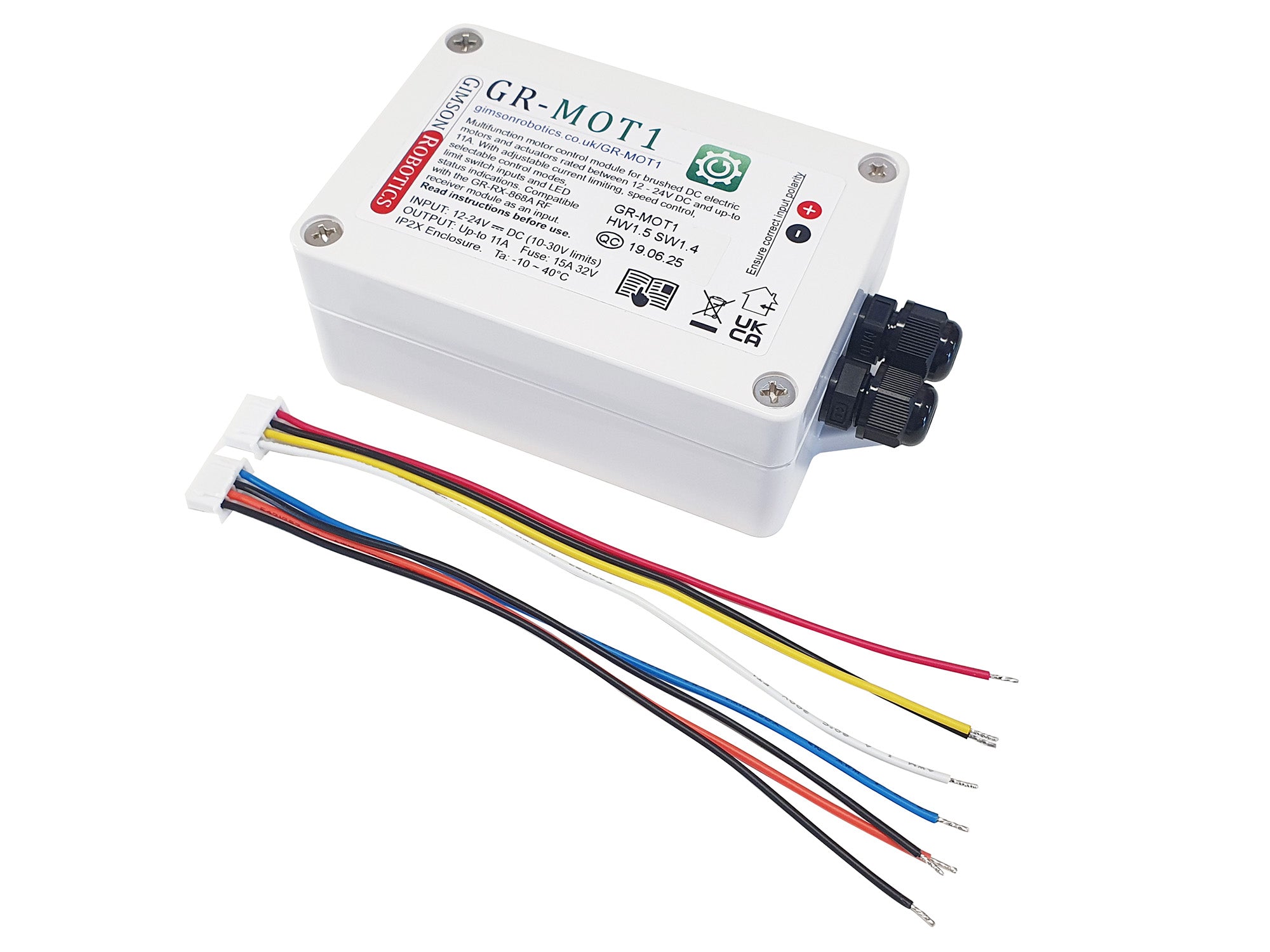The GLA800-N model shares the same compact motor and outer body of the higher-capacity and slower-travelling GLA1500-N model, but with a different lead screw size for faster travel.
It is compact, generates a much lower noise than many similarly sized actuators when in operation, and has a stylish body with a stainless steel extending rod.
Operation at 12V DC means that the actuator can be driven from most vehicle batteries or by readily available power adapters. We stock stainless steel mounting brackets designed specifically for use with the actuator.
The actuator body is rated to IP66, it may be used outdoors but ought to be shielded from direct long-term rain exposure to ensure longevity (washing/cleaning and the occasional splash are OK). The surface quality of the actuator is excellent, ideal if you want to maintain a quality look when they are in exposed areas.
As with most of our stock actuators this model has built-in limit switches at the ends of travel, meaning the actuator should stop automatically at the fully retracted and the fully extended positions.
Integrated Encoder, for position detection and synchronisation
The actuator has a hall-sensor based quadrature encoder built-in to the motor. The encoder is powered by two of the six cores of the main cable (+Vcc Red, -GND Black) and can run from a DC supply of between 5-12V. It has a dual-channel output (channel A Yellow lead, Channel B White lead), with each channel generating 17.4 pulses per millimetre of travel (4 pulses per motor revolution). One of the channels is out of phase with the other, as such it is possible to tell both the speed (from pulse frequency) and direction (by reading the pulses of one channel and comparing it to the other) of the motor. The nature of the signals that are generated is illustrated below. Given a maximum no-load travel rate of 14.5mm/s for the 12V motor (when at 12V) the pulse frequency may be up to 253Hz per encoder channel (the frequency rate may be greater than this if your controller is counting all rising/falling edges as opposed to only HIGH/LOW signal state changes). When used with the appropriate controller the encoder signals can be used for positional control with much greater accuracy and consistency than potentiometer-based actuator feedback systems.

Leads & Connector Options
The actuator comes with a 2m long PVC-insulated lead as standard, this has six internal cores: Blue and Brown (to the motor, thicker wires), Red and Black (positive and negative power to the hall sensor encoder circuit, thinner wires), and White and Yellow (outputs from the encoder, channel 1 and channel 2, also thinner wires). If you are only running a single actuator (don't require synchronised control) and don't need position/speed feedback then you can connect directly to the brown and blue motor leads and ignore the others. The connections are illustrated in the below diagram which also shows the limit switch circuit inside each actuator, in series with the brown and blue motor leads.
Options are provided above for us to add a 6-pin connector (4.2mm pitch, 3x2 format, latched) onto the actuator lead, bringing the total lead length to either 1m or 2.5m. If you have a custom lead length or connector requirement, please contact us.
User Advice
As with any brushed DC electric motor, the direction of travel is affected by the polarity of the current supplied to the two motor wires (see leads & connector description above, and on the
reference sheet, to identify the motor wires). Controlling the direction the current may be achieved using hardware such as our rocker switch harness, or GR-MOT1 control unit. By varying the input voltage between 0-12V DC it is possible to control the speed of the actuator. Reducing the voltage will also reduce load capacity (for example at 6V the actuator will have roughly half of the maximum load capacity as at 12V, and run with roughly half the no-load speed). As with any DC motor the actuator may be run at a higher voltage than the nominal 12V DC however operation at higher voltages
will invalidate the warranty as it creates an increased risk of premature failure.
Shock loads through the mounting points should be avoided (shock/impact loads may impart a force greater than the rated load through the actuator).
Be aware of the 'duty cycle' rating of the actuator, which determines the maximum proportion of the time that the actuator should be in operation for, to prevent overheating and ensure longevity. This is specified under 'Operating Characteristics' below.
Ensure that the control hardware and power source are capable of providing sufficient current for the loads you expect the actuator to experience. We cannot be held liable for damage caused to connected hardware due to inappropriate hardware selection.
A fuse, and/or other overload protection (such as active current monitoring), should be used to protect the actuator against stalling due to an overload, which can permanently damage the motor.
 Device Safety
Device Safety
Electric actuators such as this model are low-voltage electromechanical components that are used in a wide variety of different applications. It is important that the safety of each installation is assessed according to its own requirements, construction, end user and environment. Please see a list of design principles on page 3 of the
actuator reference sheet (PDF), which we strongly recommend that you adhere to in your end-application design.
CAD models (STEP, IGS, Autodesk Fusion 360) of the actuator are available upon request. Contact us with the size(s) and file formats that you require and we'll attach the files in return.
Operating Characteristics
Motor
Nominal 12V DC, up to 50W
Speed / Force
14.5mm/s no-load, reducing to 7.5mm/s at the full rated 800N

Operating current
No-load: 1.0A
Maximum load: 5.7A. If using overcurrent detection to protect the motor, ensure that this is sensitive enough to react quickly to an overcurrent event.
Maximum load
800N (81kg, 179lbs) for supported (linear) loads.The maximum load should be reduced if the load is not supported in an axial direction, parallel to the movement of the actuator. Longer-travel actuators are affected to a greater extent by off-axis loads.
Noise levels
< 48dB under no-load
< 50dB under full-load
Maximum duty cycle
15% (this is the maximum proportion of time that the actuator may be in operation for, up to 2minutes during any continuous stretch. The duty cycle should be reduced below 10% for average loads >500N)
Life expectancy
Nominal 40,000 strokes
Please be aware that there is likely to be some variation in the operating performance from actuator to actuator, allow for at least 10% difference above/below the given values. If you intend to use the actuators in sets of two or more driving the same assembly then you must ensure that the driven assembly is rigid enough to transfer forces between them effectively or else the output could twist and put excessive stress on the framework and actuators. If your structure is not very rigid, or needs to stay level throughout its travel (e.g. tabletop surfaces rising/falling level to the ground) then please get in contact to discuss automatic synchronising control options.
Actuator Build Detail
Size
(click on image to expand)
Installation length
This is the distance from the front to rear mounting hole centres
when the actuator is retracted.
| 400mm stroke: 545mm |
| 700mm stroke: 875mm |
| 800mm stroke: 1000mm |
Add the
Installation Length to the
Stroke Length to get the full travel distance, measured between the centre of the two mounting holes.
Mounting
Two 8mm holes. One is towards the end of the piston rod, the other is on the rear of the gearbox housing. Designed-for-purpose mounting brackets are available here.
Body material
Cast & extruded Aluminium, with painted Steel motor can, rated to IP66
Operating temperature
-15°C ~ +45°C
Transmission
Two-stage low-noise nylon worm-and-wheel. First stage 29:2 ratio (2-start worm), second stage 9:4 ratio (4-start worm), cumulative 32.625:1 ratio. With a 2.5mm pitch 3-start lead screw.
Limit switches
Two limit switches are installed at the ends of travel which automatically stop travel at the fully retracted and extended positions. The internal circuit is as pictured below (click on image to expand):

Cable
2m long, with 2 x 18AWG cores (Brown and Blue, to motor) plus 4 x 22AWG cores (to quadrature encoder), when the standard option is selected
Weight
When with standard lead, no connector
| 400mm stroke: 1910g |
| 700mm stroke: 2550g |
| 800mm stroke: 2760g |
If you have any questions about this item, including requests for bulk-pricing information, then please contact us.



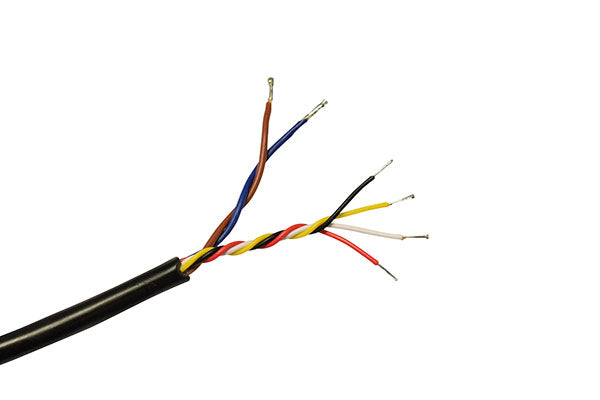
 Device Safety
Device Safety





